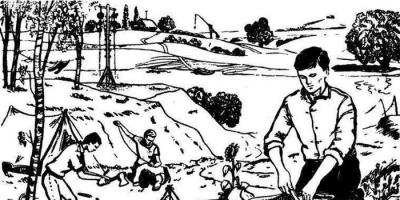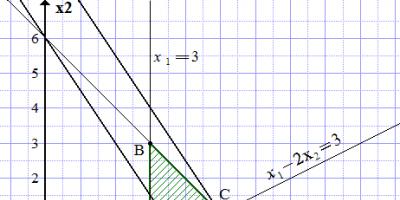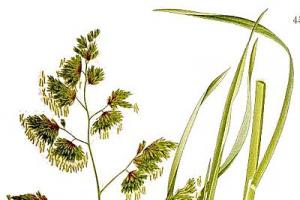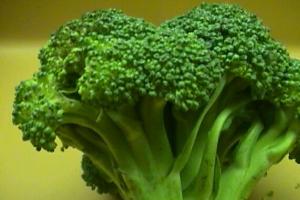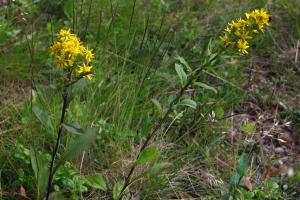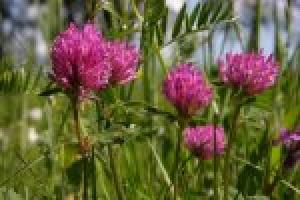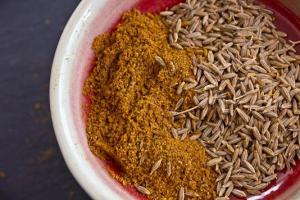| Cocksfoot | |
| |
|
| Scientific classification | |
|---|---|
| Kingdom: |
Plants |
| Department: |
Flowering plants |
| Class: |
Monocots |
| Order: |
Poaceae |
| Family: | |
| Subfamily: |
Bluegrass |
| Tribe: |
Bluegrass |
| Genus: | |
| View: |
Cocksfoot |
| International scientific name | |
|
Dactylis glomerata L. (1753) |
|
| Species in taxonomic databases | |
| CoL | |
Cocksfoot(lat. Dactylis glomerata) is a perennial herbaceous plant of the grass family ( Poaceae).
Description

Botanical illustration from the book by K. A. M. Lindman "Bilder ur Nordens Flora", 1917-1926
Upper part of a flowering plant
Tall, loose-bush perennial. The root system is powerful, spreading to a depth of 1 m. The most intensive growth of roots in depth occurs in the initial period of the plant’s life in the tillering phase. Forms an erect bush of abundant, rigid, generative, well-leafed stems. Stems are 35-130 cm tall, strong, do not lie down, straight or erect at the base. It has a mass of basal leaves, up to 1 m in length. The leaves are gray-green, wide, usually folded in a boat, 5-20 mm wide, soft, slightly rough. Sometimes it forms large, well-shaped hummocks.
The inflorescence is a dense, one-sided, usually triangular panicle (due to which the hedgehog is sharply distinguished from other cereals) 6-20 cm long with short and long branches extending from the nodes one at a time and bearing bunches of crowded spikelets. Spikelets are 4-8 mm long, 2-4 flowers, grayish-green, often with a purple tint. The lower lemma of the lower flower is 5-8 mm long, awned or with an awn 1-2 mm long, glabrous or pubescent, along the keel with long setae or spines.
Chemical composition
Spreading
Distributed in Europe, except the Arctic, northwestern regions of Asia, northern Africa and North America (naturalized). In Russia, it is common almost everywhere in the European part (except for the Arctic), in the Caucasus, and is noticeably less common in the southern regions of Siberia; It is known as an alien plant in the Far East.
Features of biology and ecology
A common plant found in various meadows on fresh or dry soils, in sparse secondary forests, in forest clearings, meadows, among shrubs, in fallow lands, on lawns, wastelands, near roads, in populated areas. It can form pure thickets, especially when the meadow is used for hay.
In spring it begins to develop earlier than many cereals. Blooms in June - August, bears fruit in September. Reproduces and spreads by seeds; Each panicle bears on average 100-400 spikelets, which, with 3-5 flowers in a spikelet, produces 300-2000 seeds.
Economic importance and application
Introduced into culture at the beginning of the 19th century. It is sown in fields in forage grass stands and used to create lawns. It is one of the best forage grasses. One of the most productive plants, produces 3600-7200 kg of hay per hectare. Under favorable conditions, a hedgehog team can produce 4 mowings per summer. In the 2nd mowing it blooms a second time. In the year of sowing it develops slowly and weakly. In the 2nd year it produces a good hay harvest, in the 3rd year it reaches full development. It stays in the grass for 8-12 years.
It is well eaten by all types of farm animals both in hay and in pasture, but hay is more suitable for horses and cattle and less suitable for young animals, goats and sheep. For small animals, hedgehog hay is rough; small spines along the edges of the leaves can cause intestinal irritation when eaten.
Literature
- Gubanov I. A., Kiseleva K. V., Novikov V. S., Tikhomirov V. N. Illustrated guide to plants of Central Russia. Volume 1: Ferns, horsetails, mops, gymnosperms, angiosperms (monocots). - M.: T-vo scientific publications KMK, Institute of Technological Research, 2002. - P. 226
- Elenevsky A. G., Radygina V. I., Bulany Yu. I. Plants of the Saratov Right Bank (flora summary). - Saratov: Publishing house Sarat. pedin-ta, 2000. - ISBN 5-87077-047-5. - P. 11
- Forage plants of hayfields and pastures of the USSR / ed. prof. I. V. Larina. - T. I Spores, gymnosperms and monocotyledons. - M., L.: State Publishing House of Agricultural Literature, 1950. - P. 344-349
- Weeds of the USSR. T. I / ed. B. A. Keller. - L.: Publishing House of the USSR Academy of Sciences, 1934. P. - 229-230
- Flora of central Russia: Atlas-determinant / Kiseleva K.V., Mayorov S.R., Novikov V.S. Ed. prof. V. S. Novikova. - M.: ZAO “Fiton+”, 2010. - P. 66
| Flora and fauna of the Rtishchevsky district | |||||||
|---|---|---|---|---|---|---|---|
| Flora of Rtishchevsky district |
|
||||||
| Mushrooms of the Rtishchevsky district |
|
||||||
| Fauna of Rtishchevsky district |
|
||||||
| Red Data Book of the Saratov Region | |||||||
| Rtishchevo and Rtishchevsky district in topics | ||||
|---|---|---|---|---|
| Symbols and awards |
|  |
||
| People of the city and region | ||||
| Administrative territorial division |
|
|||
| History of the Rtishchevsky region | ||||
| Economy | ||||
| Education and science | ||||
Syn.: common hedgehog, juzha, stick insect, dog grass, misanochnik.
A perennial grass that forms a loose bush with creeping roots and long narrow leaves. The hedgehog is widely used in agriculture as a perennial forage plant. Also, closely related hedgehog species are widely used in landscape design.
Ask the experts a question
Flower formula
The formula of the hedgehog flower is O(2)+2T3P1.
In medicine
The hedgehog is not included in the State Pharmacopoeia of the Russian Federation, but is used by official medicine in allergology when conducting allergy tests, and is also part of an allergen-specific immunotherapy for patients with hypersensitivity to meadow grass pollen.
Contraindications and side effects
Flowering plants can cause an allergic reaction to pollen called hay fever. The following symptoms may occur: acute inflammation of the mucous membranes of the eyes, respiratory tract, skin. The greatest allergenic activity is characteristic of wild cereals, which include the hedgehog.
Hay fever worsens with the beginning of flowering of certain plants. People with grain allergies should be careful between June and the end of July.
In crop production
In terms of winter hardiness, hedgehog grass is one step lower than meadow timothy and fescue. Under good snow cover it overwinters well, but in winters with little snow it freezes. It can also be damaged by late spring frosts.
The plant is sensitive to excessive soil moisture and does not tolerate close groundwater levels. Tolerates drought quite well, but with a decrease in yield. The hedgehog is quite light-loving, but at the same time shade-tolerant.
It develops best when the soil is slightly acidic and aerated.
Orchard grass is a very productive cereal and has good feeding qualities, especially when mowed in the early stages. Capable of forming 2-3 cuts or more. Capable of growing green mass for feed earlier than winter rye.
When used as fodder, harvests of hedgehog grass can be obtained for over 10 years, and on a high agricultural background, the grass lasts in grass mixtures for decades. When used as seeds, it is also durable - it can produce seed harvests for 4-7 years in a row. The plant produces its maximum seed yield in the second or third year of use.
The plant reproduces mainly by seeds, which are sown in spring or late summer to a depth of 1-1.5 cm. Shoots appear in the third week. When thinning crops, the plant forms hummocks. The hedgehog team is almost not affected by diseases and pests.
In other areas
A haymaking and pasture forage plant, widely introduced into cultivation. Can produce 2-3 cuttings per year. It is especially well eaten by cattle and horses.
Hedgehog grass is also used for sowing on slopes, since the powerful root system of the plant strengthens the soil well on them.
In landscape design it is planted as an ornamental and lawn plant. The most commonly used is the garden variety (Dactylis glomerata var. variegata Hitchc.) with striped leaf blades. Also found in grass mixtures for Moorish, drought-tolerant, or roadside turf.
Classification
Hedgehog (lat. Dáctylis glomeráta) is a species of perennial herbaceous plants of the genus Hedgehog (lat. Dactylis) of the Poaceae family.
Botanical description
Perennial plant 60-150 cm tall, with short rhizomes. The roots of the hedgehog penetrate relatively shallowly, usually up to 100 cm, that is, they are closer to the soil surface than most cultivated perennial grasses. The stem is straight, bare. The leaf sheaths are closed along the entire length, flattened, glabrous or with hairs. The tongue is up to 6 mm long, torn. The leaves are flat, 4-10 mm wide, rough. The panicle is dense or spreading, up to 15 cm long. Spikelets 3-5 (rarely 8)-flowered, oblong-elliptic, laterally compressed, 6-8 mm long. Lower spikelet scales along the keel with cilia. The lower flower scales are almost equal to the spikelets, at the apex turning into a short straight spine, up to 1 mm long, along the edges and keel with cilia.
The inflorescence is a dense, one-sided, usually triangular panicle 6-20 cm long with short and long branches extending from the nodes one at a time and bearing bunches of crowded spikelets. Spikelets are 4-8 mm long, 2-4 flowers, grayish-green, often with a purple tint.
Leaf blades are 5-20 mm wide, soft, sharply rough, flat or folded lengthwise; vaginas strongly flattened, mostly closed, rough; the tongue is 2.5-8 mm long, usually fringed torn at the top.
Hedgehog plants of the winter type of development in the year of sowing by autumn form a large number of vegetative shoots and individual generative stems. The bulk of generative stems are formed in the second year of life from shoots of summer-autumn tillering that have undergone vernalization. It blooms in the morning from 3-7 to 10-11 o'clock; in cool weather it blooms a little later. Some varieties exhibit afternoon and evening flowering. Flowering begins in the upper or middle part of the panicle, then spreads throughout the entire inflorescence and lasts 7-8 days; under unfavorable conditions, these periods are extended. In the middle zone, the hedgehog plant usually blooms in mid-June, the seeds ripen in the second ten days of July. The seeds are triangular, elongated-pointed, gray in color. The formula of the hedgehog flower is O(2)+2T3P1.
It can last up to 8-10 years in grass mixtures. When sown in its pure form, it produces good yields of hay or seeds already in the second year of life. In the third year of life it reaches full development. The highest seed yields are obtained in the second or third year of use.
Varieties and forms of hedgehogs:
‘Aschersoniana’ is a low-growing variety.
‘Variegata flava’ is a variegated variety with yellowish-green leaves. The leaves are semi-evergreen.
‘Variegata striata’ is a variegated variety with whitish or golden longitudinal stripes. The leaves are semi-evergreen. Looks great in a mixborder.
Spreading
The plant is a component of grass stands of meadows in almost all regions, with the exception of the southern Crimea, Buryatia, the Far East, Yakutia and the Arctic. Found in meadows, forest clearings, sparse forests, and anthropogenic habitats. Often grows in cereal crops.
It is successfully grown in mountainous regions and on irrigated lands of Central Asia and the Caucasus in a mixture with alfalfa and sainfoin. 20 varieties have been zoned for pasture and hay use.
Regions of distribution on the map of Russia.
Historical reference
The hedgehog species has been domesticated and cultivated since the end of the 19th century. Currently, 26 varieties of hedgehogs are used in the production. The plant takes its name “Hedgehog” from the external resemblance of its flowering spikelets to small hedgehogs. And the Latin name (lat. Dáctylis glomeráta) comes from the Greek word “dactylos” (finger) due to the peculiar shape of the common inflorescences of the most common species.
Literature
1. Gubanov, I. A. et al. 132. Dactylis glomerata L. - Hedgehog team // Illustrated guide to plants of Central Russia. In 3 volumes - M.: Scientific T. ed. KMK, Institute of Technology. research, 2002. - T. 1. Ferns, horsetails, club mosses, gymnosperms, angiosperms (monocots). - P. 226. - ISBN 8-87317-091-6.
2. Ovchinnikov P.N. Dactylis glomerata L. - Hedgehog team // Flora of the USSR. In 30 volumes / Ch. ed. acad. V. L. Komarov; Ed. volumes by R. Yu. Rozhevits and B. K. Shishkin. - M.-L.: Publishing House of the USSR Academy of Sciences, 1934. - T. II. - pp. 361-362. - 778 + XXXIII p. - 5175 copies.
3. Tsvelev N.N. Dactylis glomerata L. - Common hedgehog, team // Cereals of the USSR / Rep. ed. An. A. Fedorov. - L.: Science, 1976. - P. 516-517. - 788 p. - 2900 copies.
The stem is straight or erect at the base, 35-130 cm high, glabrous, smooth. Leaf blades 5-20 mm wide, broad-linear or folded lengthwise, sharply rough; vaginas flattened, mostly closed, rough; the tongue is 2.5-8 mm long, usually fringed-torn at the top. The inflorescence is a dense, one-sided, usually triangular, panicle 6-20 cm long with short and long branches extending from the nodes one at a time and bearing bunches of crowded spikelets. Spikelets are 4-8 mm long, 2-4-flowered, grayish-green, often with a purple tint. The glumes are hard-skinned. The grains are 3-6 mm long and 1.8 mm wide. The average weight of 1000 seeds is 1.2 g.
Distributed in Europe, northwestern regions of Asia. Common in many areas of the European part, except the Arctic, Kazakhstan, Western Siberia, in the mountains of Central Asia and the Caucasus, noticeably thinning out in Eastern Siberia, where it is found only in the southern regions; as an alien plant it is found in regions of the Far East. It grows in meadows, clearings, sparse forests and bushes, near roads, and in clearings.
The topic is discussed on ours in the “Lawn Grass Seeds” category.
Refers to forest-meadow plants with a wide ecological amplitude. Xeromesophyte: lives mainly in cenoses with sufficient moisture, but cannot tolerate prolonged flooding, and if it lasts 20-40 days, the plant falls out of the herbage; It is also found in dry areas. The optimal groundwater level for hedgehogs is 50-90 cm, and at a level above 30 cm it falls out. Grows well in partial shade. It is often damaged by late autumn frosts, especially its seedlings.
Included in the group of dominant grasses, it is common in polydominant legume-forb-grass and forb-grass associations. It can form pure thickets, especially when the meadow is used for haying (double-cutting).
Reproduces mainly by seed. The seed yield in natural cenoses is 1.44-2.55 c/ha, and in cultural conditions - on average 4-6 c/ha. The duration of seed dormancy after they fall is 8-9 months. Under optimal conditions, seed germination lasts for at least 3 years. Mass emergence of seedlings is usually observed in May. Many seedlings, up to 60%, die. Those that survive, by the end of the growing season, form 4-6 green leaves and a well-developed secondary root system. In the second year, the plants begin to bush, and in the third or fourth year they enter the phase of formation of generative shoots. Old turfs usually disintegrate into separate areas with sharply reduced shoot formation. The hedgehog blooms at the end of June - July, although generative buds are laid in the fall. Flowering occurs in the morning, but depends on weather conditions. The total flowering time of one plant is 8-12, and the inflorescence is 6-8 days. Blooming of one flower lasts about 1.5 hours. In dry weather, flowering is faster. In some habitats, the hedgehog has been observed to form viviparous buds.
Refers to valuable fodder plants. 100 kg of hay harvested at the beginning of flowering contains 54.5 feed. units and 4.3 kg of digestible protein. The carotene content in 1 kg of feed ranges from 1 mg in hay to 4 mg in grass. The maximum yield of green mass under cultural conditions occurs already in the 2-3rd year of life. The average hay yield for two cuttings is up to 50-60 c/ha. Responsive to fertilizers, especially phosphorus-potassium. In hay and pasture it is well eaten by all types of livestock, but especially by cattle and horses.
It tolerates grazing satisfactorily, but livestock on pastures do not eat overgrown hedgehogs well. It vegetates early and grows back well after feeding or mowing. Used to create lawns.
Common varieties: VIC-61; Morshanskaya-89, 143; Dedinovskaya-4, Torpedo, etc.
VIC-61
Winter hardiness is high, drought resistance is satisfactory. Dry matter collection 8-10 t/ha, seed yield 400-500 kg/ha. Well eaten by all types of farm animals. Case-shaped disease is affected to a weak degree. Cultivation zones: approved for use in the Northern, Northwestern, Central, Volga-Vyatka, Middle Volga regions. Recommendations for cultivation: intended for hay and pasture cultivation in pure form and in grass mixtures. Responsive to fertilizers and irrigation. It grows very quickly. Grows well in medium to heavy loamy soils.Morshanskaya-89
Winter hardiness and drought resistance are high. The yield of dry matter when tested at Zolsky GSU was 7.8 t/ha. Seed yield up to 600 kg/ha. Moderately affected by brown rust. Prefers normally moist fertile soils. Cultivation zones: approved for use since 1989 in the North Caucasus region. Recommendations for cultivation: it has a high growth rate in spring and after mowing, it is recommended for pasture use, and can also be used for making hay.Morshanskaya-143
Mid-season variety, high winter hardiness and drought resistance. Dry matter collection is 6-7.5 t/ha, seed yield is 300-400 kg/ha. It is weakly affected by diseases. Cultivation zones: approved for use in the Central Black Earth and Far Eastern regions. Recommendations for cultivation: recommended for pasture and hay use, it has good shade tolerance. Grows well on chernozem and other fairly fertile soils.Dedinovskaya-4
An early variety, good winter hardiness, satisfactory drought resistance. Dry matter collection when applying nitrogen fertilizers is 10-12 t/ha. Seed yield is 300-400 kg/ha. The crude protein content in hay with multi-cut use is 15-22%. Resistant to major diseases and pests. Cultivation zones: approved for use in the Northern, Northwestern, Central, Volga-Vyatka, Far Eastern regions. Recommendations for cultivation: suitable for use in floodplain, lowland and upland meadows as a haymaking and pasture variety. Withstands flooding for up to 14 days.Torpedo
Mounted, loose-bush grass of winter type of development. It grows faster than other cereals in the spring and after mowing it provides the earliest green fodder. Responds well to nitrogen fertilizer and watering. It has high winter hardiness and is more drought-resistant compared to other cereals. Resistant to lodging. The bush is erect, bushiness is strong. Plant foliage is high 67-78%. Early ripening cereal. Length of the growing season: from spring regrowth to the 1st cutting 43-54 days, from 1st to 2nd - 32-43, from 2nd to 3rd - 34-45 and from 3rd to 4th th - 28-32, until the seeds ripen 89-98 days. It grows well on chernozem soils and responds effectively to high fertility. In hayfields and pastures it lasts up to 8 years. Weakly affected by brown rust. The variety is resistant to damage by pests. On average, over 6 years of use when applying N240, the yield of green mass from 4 cuttings was 45 t/ha, dry matter - 8.6 t, seeds - 0.3 t/ha. The content of crude protein in the dry matter of the feed reaches 15-18%, fiber does not exceed 25-28%. Can be used for irrigated hayfields and pastures as the first link of a green conveyor. It is well eaten (if mowed early) by all types of livestock. It has high technology in production.Birskaya-1
Included in the State Register for the Ural region. The bush is semi-loose, medium dense. Stems are round, erect, pubescent, medium soft. The leaves are lanceolate, pubescent, light green to dark green in color. The tongue is elongated, pointed, dense. The inflorescence is a one-sided panicle, medium loose, with an anthocyanin tint. The seeds are grayish-yellow with a green tint. The average dry matter yield in the region exceeded the average standard by 5.6 c/ha. It was slightly affected by rust, just like the standard.Bylina
Included in the State Register for the West Siberian region. The bush is erect. The stems are round, flattened at the base, without pubescence, green. The leaves are flat, linear, soft, green, dark green, medium drooping, and have a slight waxy coating. The tongue is elongated and pointed. The inflorescence is a panicle, compressed before and after harvesting, greenish. The seeds are oblong, almost 3-sided, awn-shaped, pointed, gray. The average dry matter yield is 50.8 c/ha, at the level of the average standard. Slightly affected by helminthosporiosis.Genra
Included in the State Register for the North Caucasus region. Diploid. The bush is intermediate in the fall of the year of sowing, and semi-erect when the inflorescences are borne. The leaf is light green, wide. The time for the inflorescences to emerge is early. The flag leaf is short and of medium width. Stem of medium length. The upper internode is of medium length - long. The inflorescence is of medium length, there are no flint teeth. The average dry matter yield over the years of testing in the region is 29.1 c/ha, at the standard level. It was slightly affected by Septoria and rust.Lidakta
Included in the State Register for the North-Western and Central regions. Tetraploid. Bush is intermediate to semi-creeping. The leaf is green to dark green. The tendency to form inflorescences in the year of sowing is strong to very strong. The time of appearance of inflorescences in the second year is average. The shape of the bush when inflorescences appear is from semi-erect to intermediate. The flag leaf is short to medium, medium width. The stem is short to medium. The inflorescence is short to medium. The average dry matter yield in the North-West region exceeded the average standard by 1.6 c/ha, in the Central region - by 6.4 c/ha.For more information, visit our section -
Hedgehog is a universal plant that is used for agricultural and landscape design purposes. The grass is common in North America, Eurasia, and North Africa. It grows on river banks, clearings, wastelands, roadsides and other areas. The cereal is a persistent, unpretentious, well-adapted plant. Widely represented in the European territory of Russia and the Caucasus.
Botanical description
Cocksfoot -
perennial loose bush (photo attached below). 
Prefers a temperate climate and adapts well to non-chernozem zones.
Did you know? The plant received the non-trivial name “hedgehog” due to the external similarity of its flowering spikelets with the needles of the common hedgehog.
External characteristics of the cereal:- has a short creeping rhizome, grows into the soil to a depth of 100 cm;
- the height of the stems reaches 150 cm, width - 1.5 mm, smooth, flattened, even, slightly twisted at the base;
- leaf width is 5-12 mm, dull green in color, quite rough and sharp at the edges;
- leaf sheaths are bare, flattened and closed;
- the inflorescence has the shape of a panicle, which reaches 15 cm, dense and spreading;
- tongue length - up to 6 mm, torn;
- spikelet length - 5-8 mm, 3-5 flowers, oblong shape, flattened on the sides;
- fruits are caryopsis-shaped, triangular and oblong;
- weight of 1000 seeds - 0.8-1.2 g.
 The grayish-green inflorescences of the cereal are located at the tops of the stems. Hedgehog flowers resemble a panicle shape with short oblong branches and may have a purple tint.
The grayish-green inflorescences of the cereal are located at the tops of the stems. Hedgehog flowers resemble a panicle shape with short oblong branches and may have a purple tint. They bloom from June to August. Fruit harvesting occurs between July and September.
Types of hedgehog:- Aschersoniana - a low-growing species of hedgehog;
- Variegata flava is a variegated species with yellow-green leaves;
- Variegata striata is a variegated species with whitish or golden oblong stripes.
Characteristics of culture
Hedgehog is a valuable forage crop. In the year of sowing, the cereal develops poorly and only at 2-3 years of age produces a good harvest. 
Plant yield:
class="table-bordered">
The plant does not tolerate moisture well and is resistant to drought. Sensitive to autumn frosts and spring colds, stagnant waters, does not tolerate snowless winters and freezes without snow cover.
Important! The hedgehog has good regrowth, and therefore it can be mowed several times a season. Harvesting occurs during the period when the panicles are thrown out and before the cereal begins to flower, after which the hay loses its beneficial properties.
Due to its unpretentious and sustainable properties, the grass is used for creating lawns, as well as for decorating them. 
General description of the hedgehog:
Advantages:
- the plant is grown in different conditions;
- longevity - 6-8 years;
- grows well on moderately fertile light to heavy soils;
- shade-tolerant;
- grows until the first hard frost;
- resistant to pests and diseases;
- used for medical purposes;
- used to strengthen slopes and slopes (thanks to the developed and stable root system).
- as feed it is less nutritious than other cereal crops;
- releases specific toxins into the soil (it is not planted on noble lawns, as it can eradicate other plants).
 Hedgehogs are propagated in spring or late summer. The first seedlings appear 2.5-3 weeks after sowing.
Hedgehogs are propagated in spring or late summer. The first seedlings appear 2.5-3 weeks after sowing. The grain reproduces:
- seeds that are sown in late summer or spring to a depth of 1-1.5 cm;
- dividing the bush. The procedure is carried out in spring and autumn.
Important! Flowering hedgehogs can provoke hay fever, that is, an allergic reaction to pollen. Symptoms of the disease: acute inflammation of the skin, respiratory tract and mucous membranes of the eyes.
Features of cultivation
The hedgehog plant should be planted in dry habitats, although it is also resistant to moderately moist, damp soils. Loose fertile clay and loamy soils are preferable for this crop. In and near swamps, grass dies from excess moisture.  It grows back quickly after feeding or mowing. In early spring, hedgehogs must be fed for better growth and harvest. For example, phosphorus-potassium will ensure longevity in grass stands and increase its accumulation in the plant.
It grows back quickly after feeding or mowing. In early spring, hedgehogs must be fed for better growth and harvest. For example, phosphorus-potassium will ensure longevity in grass stands and increase its accumulation in the plant.
Sowing seeds in rows with inter-row spacing is the most perfect, since sowing and planting of seeds occurs simultaneously, which means they are in the same conditions. As a result, germination and emergence of plants will occur simultaneously, which will reduce crop loss during processing and harvesting.  The economic suitability of sowing seeds is 10 kg per 1 ha. Seed collection occurs from the second year of cultivation. In the first year of sowing, you need to loosen the rows twice and weed by hand. In subsequent years, loosening is carried out in spring and autumn, as well as shelving. Full fertilization is done in the 3rd year.
The economic suitability of sowing seeds is 10 kg per 1 ha. Seed collection occurs from the second year of cultivation. In the first year of sowing, you need to loosen the rows twice and weed by hand. In subsequent years, loosening is carried out in spring and autumn, as well as shelving. Full fertilization is done in the 3rd year.
Did you know? The hedgehog was cultivated and began to be used in agriculture from the end of the 19th century.
Medicinal properties and chemical composition
The cereal is used as an antitoxic substance and helps improve the functioning of the gastrointestinal tract.
Urchin pollen can cause an allergic reaction; it is used for diagnosis and treatment against allergies.
The chemical composition of hedgehogs consists of:
- magnesium (improves carbohydrate metabolism, stimulates the formation of proteins, reduces excitation in nerve cells and relaxes the functioning of the heart muscles);
- (maintains fluid balance in the body);
- copper (breaks down fats and carbohydrates);
- (protects against bacteria, forms protective immune cells);
- carotene (protects cells from viruses and bacteria, improves vision, strengthens bones, prevents hair loss and brittle nails);
Hedgehog (Dactylis glomerata L.). Perennial upland loose bush grass. It grows almost everywhere in the grass stands of natural meadows. Often found in forest and forest-steppe zones. The hedgehog is a valuable component of highly productive meadows. Tall (up to 120 cm or more) grass, forming a multi-stemmed bush with a large number of basal leaves. Along with generative ones, it forms numerous vegetative, well-leafed shoots. Leaves make up 50-85% of the harvest. When there is insufficient supply of nitrogen, plants appear yellowish-green; when there is an abundance of nitrogen, they appear bluish-green.
A powerfully developed root system penetrates to a depth of 1 m, but the bulk of the roots are located in the upper layer of soil.
It grows quickly in spring and provides early pasture food. When applying fertilizers, it produces 200-250 centners of green mass per 1 hectare already in early June. Hay and green fodder of hedgehogs in the heading phase contain up to 10% protein, 40 feed units. Due to its high properties, it is well eaten by all types of animals, however, after sweeping, as well as with a lack of nitrogen, especially in the second half of summer, its palatability decreases sharply.
Drought and frost resistance are low, sensitive to high groundwater levels and excessive moisture, and does not tolerate flooding.
Grows well in loamy soils rich in humus.
It responds better than other cereals to moisture supply and abundant fertilizer. When irrigated, it effectively absorbs nitrogen. The mortality rate of hedgehogs is high, which makes it possible to remove hedgehogs from grass stands 5-6 times. It is very resistant to pasture use and, under favorable conditions, remains in the grass for decades.
With sufficient nitrogen supply, it displaces other grasses from the grass stand. Considering this “aggressiveness”, its participation in grass mixtures should be reduced. To preserve legumes in the herbage with hedgehog grass, special methods of use are required. For example, if the early grown green mass of the hedgehog is removed by grazing or mowing, then legumes, in particular white clover, will not be forced out of the grass stand and will provide abundant, high-quality pasture food during subsequent grazing.
Of the cereal grasses, the grass grass is the most responsive to irrigation with clean and waste water.
Schmauder and others found that with increasing irrigation intensity, the participation of hedgehogs in the grass stand increases from 14% (without irrigation) to 50% (in the variant with the maximum watering rate). Despite the fact that in the experiments, the hedgehog compound accounted for only 5% by weight of seeds in the pasture grass mixture when sowing, when irrigated it took a dominant position due to other components: timothy grass, meadow bluegrass, meadow fescue, and perennial ryegrass. However, according to the observations of E. Kreutz, when long-term cultivated pastures are irrigated with high rates of wastewater, the hedgehog grass is replaced by lower grasses over time.
According to research from the Department of Meadow Growing of the TSHA, when a cultivated pasture is irrigated with river water, the yield of green mass of hedgehog grass (pure sowing) reaches 343 centners, and its mixture with awnless brome and meadow fescue - 486 centners per 1 ha.


